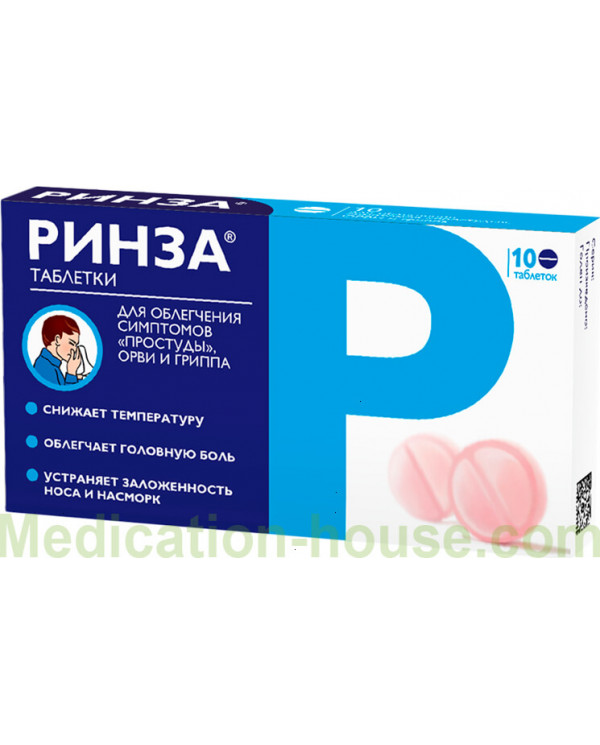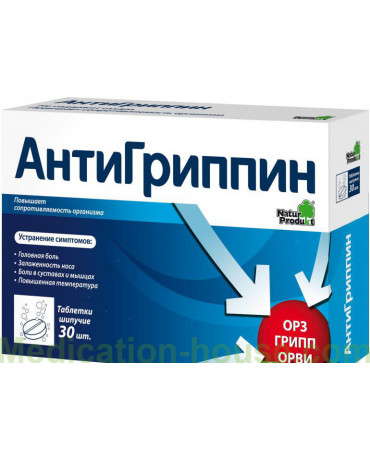Instruction for Rinza
Reed more and buy Rinza here
Rinza is a multicomponent drug used in the symptomatic treatment of acute respiratory diseases.
Release form and composition
Dosage form of Rinza release is tablets: flat, round, pink with white and dark pink blotches, on one side have beveled edges and dividing risk (10 each in blisters, in a cardboard bundle 1 or 2 packages; 10 or 20 pcs. In blisters, in a cardboard bundle 1 blister).
Active substances in 1 tablet:
Caffeine - 30 mg;
Paracetamol - 500 mg;
Chlorphenamine maleate - 2 mg;
Phenylephrine hydrochloride - 10 mg.
Additional components of Rinza: corn starch (for 20% paste), colloidal silicon dioxide, povidone (K-30), corn starch, magnesium stearate, methyl parahydroxybenzoate sodium, carboxymethyl starch sodium (type A), talc, crimson dye (Ponso 4R).
Pharmacological properties
Rinza has an antipyretic, analgesic, psychostimulating, antihistamine and anti-congestive (reduces swelling) effect.
Pharmacodynamics
Paracetamol provides an antipyretic and analgesic effect of Rinza. It helps to eliminate fever, and also relieves headaches, pain that occurs during acute respiratory viral infections, pain in the throat, back, joints.
Paracetamol is an inhibitor of the enzymes cyclooxygenase-1 and cyclooxygenase-2, reduces the production of prostaglandins and affects the center of thermoregulation of the nervous system. In inflamed tissues, the substance is blocked by specific enzymes, so the inactivation of COX-1 and COX-2 in them is negligible. This explains the weak anti-inflammatory effect of paracetamol. However, it successfully inhibits the production of prostaglandins in the cells of the nervous system, therefore, it reduces the elevated body temperature, while not affecting its normal indices. The substance does not affect the gastric mucosa, unlike other NSAIDs. Reception of paracetamol in therapeutic doses does not change the course of water-electrolyte metabolism and other types of metabolism.
Phenylephrine is an α1-adrenergic agonist that helps to reduce vascular lumen, which eliminates edema and hyperemia of the mucous membrane of the nasopharynx, nose and sinuses.
Chlorphenamine is a histamine H1 receptor blocker and is characterized by an antiallergic effect, which is expressed in eliminating exudative manifestations, reducing swelling and hyperemia of the mucous membranes of the upper respiratory tract and sinuses, and reducing the severity of itching of the throat, nose, and eyes.
Caffeine stimulates the nervous system, causing a decrease in feelings of fatigue and drowsiness and increase physical and mental performance. The compound enhances the analgesic effect of paracetamol and accelerates its onset.
Pharmacokinetics
There is currently no information on the pharmacokinetic profile of Rinza. However, it is known that paracetamol is rapidly absorbed from the middle sections of the gastrointestinal tract and intensely binds to plasma proteins. Its maximum plasma concentration is reached approximately 1 hour after administration. Paracetamol also crosses the blood-brain and placental barriers.
Indications for use
According to the instructions, Rinza is used in the symptomatic treatment of colds, acute respiratory viral infections (ARVI), including influenza, occurring with pain, rhinorrhea and fever.
Contraindications
Absolute:
Severe diabetes mellitus;
Severe atherosclerosis of the coronary arteries;
Severe arterial hypertension;
Combined use with preparations containing components included in Rinza;
Combined use with tricyclic antidepressants, monoamine oxidase inhibitors, beta-blockers;
Age up to 15 years;
The period of pregnancy and breastfeeding;
Hypersensitivity to the components of the drug.
Relative (Rinza tablets should be taken with caution in the presence of such conditions / diseases as):
Blood disease
Prostatic hyperplasia;
Arterial hypertension;
Bronchial asthma;
Hyperthyroidism;
Diabetes;
Glucose-6-phosphate dehydrogenase deficiency;
Pheochromocytoma;
Chronic obstructive pulmonary disease;
Congenital hyperbilirubinemia (Dubin-Johnson, Gilbert, Rotor syndromes);
Angle-closure glaucoma;
Hepatic / renal failure.
Instructions for use Rinza: method and dosage
Rinza tablets are taken orally.
Single dose - 1 tablet. The recommended frequency of taking the drug is 3-4 times a day (maximum - 4 tablets per day).
The duration of the treatment course is up to 5 days.
Side effects
Cardiovascular system: increased blood pressure, tachycardia;
Urinary system: interstitial nephritis, glucosuria, renal colic, papillary necrosis;
Digestive system: dry mouth, nausea, vomiting, epigastric pain, hepatotoxic effect;
Respiratory system: bronchial obstruction;
Hemopoietic system: pancytopenia, anemia, agranulocytosis, thrombocytopenia, aplastic / hemolytic anemia, methemoglobinemia;
Central nervous system: violation of falling asleep, dizziness, increased irritability;
Organ of vision: paresis of accommodation, dilated pupil, increased intraocular pressure;
Allergic reactions: itching, angioedema, skin rash, urticaria.
Overdose
An overdose of Rinza is most often caused by paracetamol and manifests itself after taking the latter in high doses (10-15 g). Among the possible symptoms, it is worth noting an increase in prothrombin time, increased activity of hepatic transaminases, pallor of the skin, hepatonecrosis, nausea, vomiting, anorexia. If you suspect an overdose, you should immediately consult a doctor.
As a treatment, gastric lavage is usually recommended, followed by the use of a sorbent (activated carbon). In the future, symptomatic therapy is also prescribed, including the introduction of methionine 8-9 hours after an overdose and acetylcysteine - 12 hours later.
special instructions
While taking Rinza, you need to refrain from drinking alcohol, anxiolytic / hypnotic drugs.
Do not take the drug in combination with other paracetamol-containing drugs.
During therapy, from driving a car and working, during which a patient needs an increased concentration of attention and quick psychomotor reactions, it is necessary to refuse.
Drug interaction
The combined use of Rinza with certain drugs / substances can lead to the development of the following effects:
Halotan: increased likelihood of ventricular arrhythmias;
Monoamine oxidase inhibitors, sedatives, ethanol: increased action;
Antidepressants, antiparkinsonian / antipsychotics, phenothiazine derivatives: increased likelihood of dry mouth, urinary retention, constipation;
Tricyclic antidepressants: increased adrenomimetic action of phenylephrine;
Glucocorticosteroids: increased likelihood of developing glaucoma;
Diuretic drugs: a decrease in their effectiveness;
Monoamine oxidase inhibitors, furazolidone: development of arousal, hypertensive crisis, hyperpyrexia;
Ethanol: increased sedative effect of antihistamines;
Barbiturates, diphenin, carbamazepine, rifampicin and other inducers of microsomal liver enzymes: increasing the likelihood of developing hepatotoxic effects of paracetamol;
Guanethidine: a decrease in its hypotensive effect, increased alpha-adrenostimulatory activity of phenylephrine.
Terms and conditions of storage
Store in a dry, dry place out of the reach of children at temperatures up to 25 ° C.
Shelf life is 3 years.
Reviews for Rinza
The numerous reviews of Rinza, which are left by doctors and patients, are mostly positive. There are practically no reports of cases of overdose or the development of adverse reactions. Sometimes there are discussions among patients about Rinza's belonging to antibiotics, but the drug does not have an antibacterial effect according to the explanations of specialists.
Terms of sell
You can buy Rinza without a prescription.


